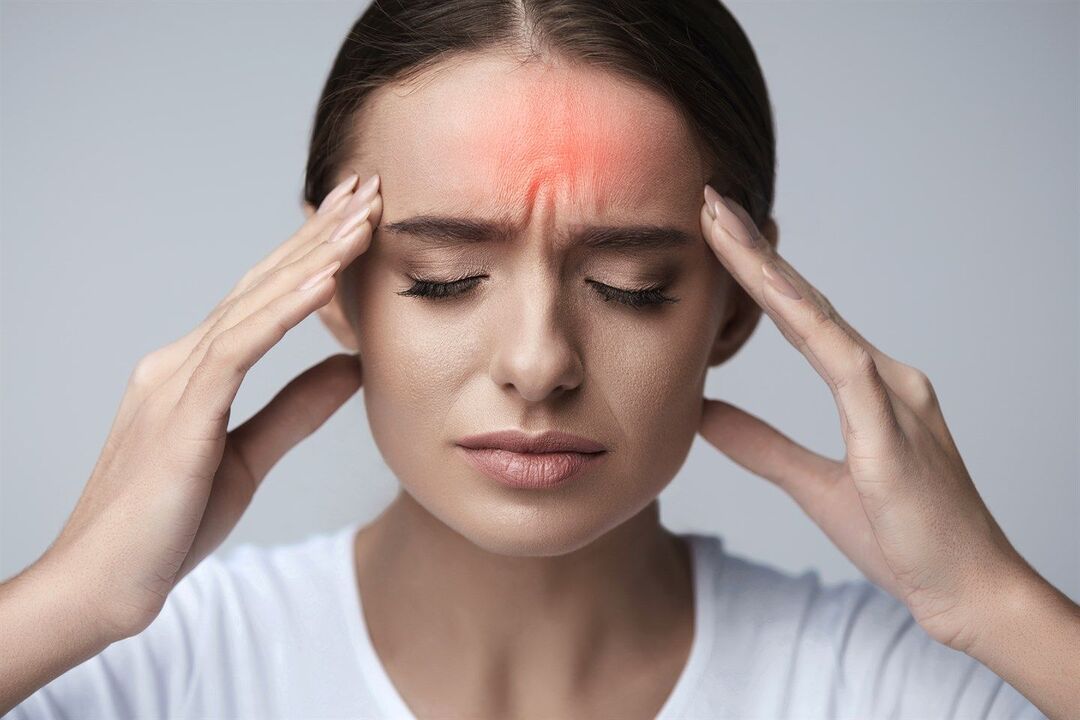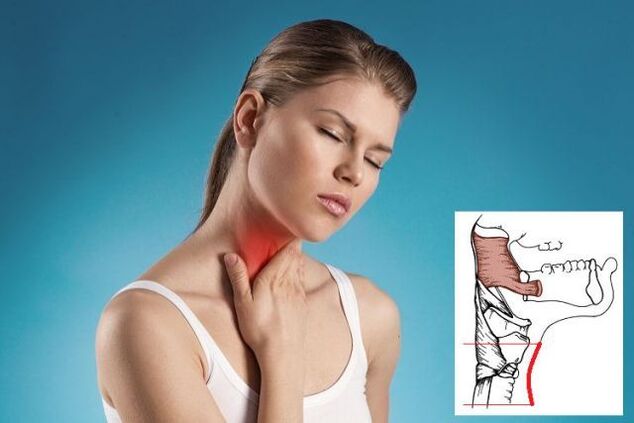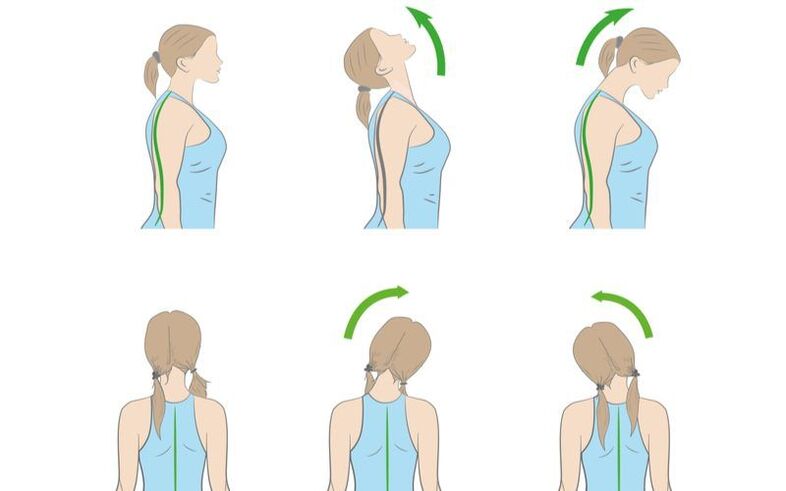Cervical cartilage degeneration is a progressive degenerative-dystrophic lesion of the intervertebral discs located between the first 7 vertebrae. Vertebrae 1-7 belong to the cervical spine.
Pathological changes in the setting of osteoarthritis lead to deformation of the vertebrae, eventually disrupting blood supply, nerve conduction in the neck, and innervation areas of damaged nerves.
Cervical spondylosis can be an independent disease or combined with osteoarthritis in other parts - thoracic and lumbar.
Main symptoms
The leading symptom of cervical spondylosis is pain, the location and nature of the disease depends on the location of the damage. Usually it is felt in the neck area, one or both arms.
This disease is characterized by unilateral pain and can hurt any part of the arm - shoulder, forearm, hand and even fingers. Many patients complain of headaches and dizziness.
The pain syndrome can also be felt in the chest, supraclavicular area or spread throughout the back. For some people, the pain is concentrated in the neck or throat.
Cervical spondylosis is characterized by a variety of symptoms and is often accompanied by tactile sensitivity disorders, muscle weakness, vision and hearing loss, tachycardia and panic attacks.
Attention! Sometimes cartilage degeneration is complicated by vertebral artery syndrome, which can require emergency hospitalization.
first sign
In the early stages, the manifestations of osteochondrosis are more reminiscent of normal fatigue after a busy day and occur cyclically. In the evening, discomfort and pain appear in the neck, heaviness and headache, mainly in the occipital region. May make crunching and squeaking sounds when turning.
Signs of cervical spondylosis in women are more pronounced than in men and are often accompanied by an unstable psychological and emotional state. In addition, men get this disease less often.
Worsening of cartilage disease often occurs during menopause, when women's bodies experience hormonal changes and the immune system weakens. Certain difficulties arise during diagnosis due to the fact that the signs are similar to those of many other diseases.

The severity of symptoms depends on the stage of the disease, the nature and extent of spinal damage.
Males are less responsive to little things like neck rattles and often simply do not notice suspicious symptoms. Furthermore, symptoms of cervical spondylosis in men may not appear for a long time, which is explained by the peculiarities of anatomy.
Men naturally have stronger and more developed muscles, which provides more support for the spine. The muscular skeleton acts as a kind of armor that protects the vertebrae and prevents their deformation.
Vertebral artery syndrome (VAS)
The clinical picture of SPA is often presented by several symptoms, but only one of the possible symptoms can be observed:
- headache with localization mainly in the back of the head and base of the skull - basic migraine, accompanied by classic symptoms: loss of coordination, nausea leading to vomiting, tinnitus, less often- impaired speech;
- Dizziness occurs when turning the head. They may be accompanied by vomiting, dark circles around the eyes, and impaired coordination of movements;
- eye fatigue due to stress, flashing spots and flashes of light before the eyes and in some places loss of visual field. Patients may complain of pain, redness and a feeling of sand in the eyeball, conjunctivitis;
- Tinnitus is continuous or intermittent, the nature of which changes depending on the position of the neck. There may be mild deafness, stuffy ears, and unresponsiveness to soft voices. In some cases, paracusia has been noted - selective hearing of sounds, in which a person hears better in the presence of external noise than in complete silence;
- Vegetative symptoms always occur when osteonecrosis becomes more severe and are often combined with other symptoms. These can be hot flashes or chills, heavy sweating, cold feet and hands, feeling short of breath, increased blood pressure and poor sleep;
- TIA - transient ischemic attack - is accompanied by mechanical compression of the vertebral artery and is manifested by double vision, temporary partial blindness due to loss of visual field, dizziness with vomiting, functional disordersspeaking and swallowing;
- Fainting can be the result of a sudden head turn or an uncomfortable position. Loss of consciousness lasts for varying periods of time and leaves weakness in the limbs;
- Drop attacks are sudden falls, usually without loss of consciousness, caused by a sudden rush of blood to the brain when the head is thrown back. The immediate cause is paralysis of both legs, but motor function is restored quite quickly.
Headache and dizziness
Most patients with cervical cartilage disease have this symptom, but they may not have any. The cause of dizziness is associated with compression of the main arteries and blood vessels, disrupting the transport of oxygen to the nervous tissue of the medulla and spinal cord.
Under the influence of mechanical trauma to the vertebral structures and chronic ischemia of nerve fibers, sensitivity increases and irritation of nerve endings occurs, which ultimately causes dizzinessin the neck.

A headache caused by cartilage disease can be distinguished by its location in the back of the head. However, there are also atypical cases of pain in the entire head or one side of the head.
Dizziness may be accompanied by uncertain movements, increased heart rate, increased blood pressure, and increased sweating in the face and shoulders.
Headaches are a frequent companion of cervical cartilage disease. It has a paroxysmal nature, the duration of the attack varies from several hours to several days. The intensity of the pain varies, but it appears with enviable regularity.
Headaches are caused by compression of the vertebral artery due to changes in the position of the vertebrae and intervertebral discs. Due to compression of the vessels, blood supply to the brain is interrupted, leading to pain.
Authority to solve:
The cause of pain can also be muscle spasms, typical of osteonecrosis.
Panic attack
Panic attacks are also associated with reduced nutrition to the brain and cause the following symptoms:
- fever or chills, increased body temperature;
- numbness, tingling in limbs, cramps, impaired mobility;
- dizziness, loss of coordination, black eyes;
- pain behind the sternum or left chest, rapid pulse, increased blood pressure;
- insomnia, fear of death or mental confusion or confusion;
- shortness of breath, difficulty breathing to the point of suffocation, throat congestion;
- abdominal discomfort and pain, indigestion, frequent urination.
Sore throat
The throat with osteoarthritis often becomes painful when the 4th cervical vertebra is damaged or displaced. The positioning is usually unidirectional, as the vertebrae and discs move to one side.

Sore throat is due to impaired distribution of the throat muscles due to nerve compression
Due to compression of the root, the throat muscles become spasmed and tense, accompanied by pain. The throat feels heavy and bloated, making it difficult to breathe. However, there are no mechanical impediments to free breathing and swallowing; There were no foreign bodies or tumors in the esophagus and larynx.
Usually, medications for tonsillitis or sore throat, mouthwash, and inhalation are ineffective.
The origin of the pain is in the area between the thyroid cartilage and the neck cavity. The nature of the pain ranges from mild to debilitating.
Treatment
Complex treatment of cervical spondylosis includes several methods - taking medications, performing therapeutic exercises, attending physiotherapy and massage sessions. If desired, you can use folk remedies and make various compresses, prepare infusions and decoctions.
In case of exacerbation of the disease, bed rest should be observed. Furthermore, you should lie on a flat and fairly hard, resilient surface - a hammock sofa or feather bed will not work.
Attention! Severe pain requires immediate medical attention.
To immobilize the cervical spine, your doctor may prescribe a Shants collar. It supports the neck in the anatomically correct position, eliminating movement and thus reducing pain.
The drug is selected taking into account the existing symptoms and diagnostic results. If hernias and protrusions are detected, treatment may be surgical.
| Medicine | Work |
| Active ingredient: Pentoxifylline | Improves cerebral circulation, dilates blood vessels, relaxes smooth muscles, reduces nerve signal frequency |
| The preparation contains chondroitin and glucosamine | Restores disc cartilage tissue, slowing down the degeneration process |
| Muscle relaxants | Reduce muscle spasms |
| Nonsteroidal anti-inflammatory drugs | Reduces inflammation and tissue swelling |
| Analgesic | Eliminate pain |
| drug | For severe pain that cannot be relieved by conventional measures |
| Vitamin complex contains vitamins B, A, C, calcium | Strengthens nerve tissue, muscles and bones, overall healing effect |
| Antidepressants and sedatives | Coping with stress caused by constant pain |
Treatment at home
You should not stay at home for too long and rest in bed. After the acute symptoms subside, you need to switch to active activities. You should start with simple exercises and gradually move to more intense exercises.

Performing neck exercises helps strengthen the neck muscles, thereby preventing attacks from recurring
Exercise 1 – self-expansion. Stand with your hands alongside your body, tilt your head to the right, and at the same time bring your left hand down. Maintain this position and repeat the exercise on the other side.
Exercise 2 – self-massage. Place the scarf on your shoulders and, holding its edges, pull them in one direction or another.
Exercise 3 – turn your head left and right, tilt it to the right and then to the left shoulder.
Exercise 4 – similar to hand counters: when turning or leaning, press on the temples, creating additional resistance.
Tips to prevent osteoarthritis
Tip #1
Physical education is the main way to fight the aging of the body and the development of disc dystrophy. Usually, daily exercise and visiting the pool at least once a week is enough. All this allows you to strengthen the muscles of the spine.
Tip number 2
Even a healthy person needs a massage, which should be done annually.
Tip number 3
It is very important to monitor your weight and avoid gaining extra pounds.
Tip number 4
When working in a forced position for a long time, you need to take breaks, change your body position and warm up.
Tip #5
Eating well means consuming enough vitamins and trace elements in food.
Tip number 6
Try not to lift or carry heavy objects, and if you must do this, wear a supportive corset.
Frequently asked questions
When do you need to see a doctor urgently?
Reasons that require immediate consultation and even calling an ambulance are:
- persistent numbness of the arms or legs;
- severe pain that is not relieved by regular pain relievers;
- movement disorders;
- severe headache, dizziness, loss of coordination and other signs of stroke;
- "stuck" the back in a certain position, limiting strong movements.
Can cartilage disease be cured permanently?
No, this is a chronic disease with periodic acute exacerbations. Even after treatment and following all your doctor's recommendations, the cartilage in the affected disc area is still replaced by scar tissue. This means that the structure of the segment has been damaged and this process cannot be reversed. However, with some effort on the patient's part, a high quality of life can be achieved.
























